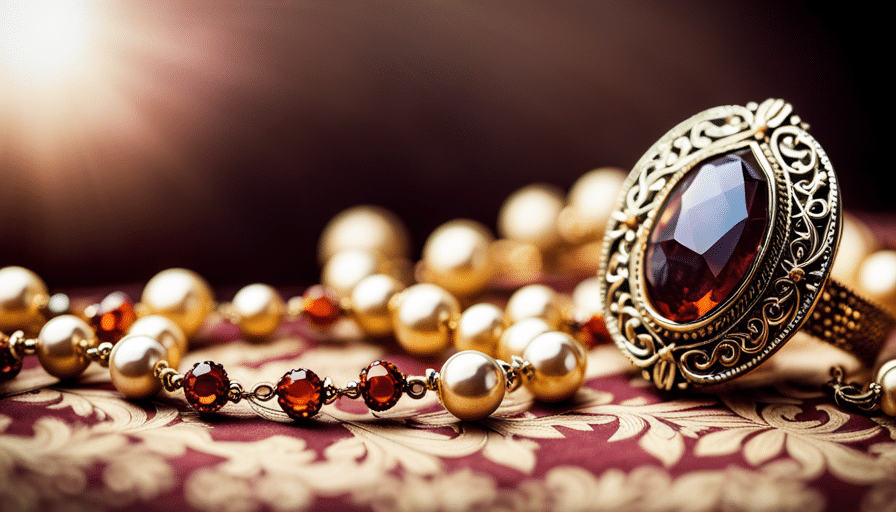Blog
The Art of Vintage Jewelry: A Guide to Preloved Luxury
When it comes to preloved luxury items, there is a world of hidden treasures awaiting your discovery. At BACALLI, we invite you to join us on a journey through time and style.
Our comprehensive platform is your gateway to understanding the allure and significance of these preloved treasures. From the defining traits of vintage items to the practicalities of owning and caring for these luxury pieces, every aspect is highlighted with meticulous detail.
With stunning visuals and insightful information, BACALLI is a must-visit for anyone captivated by the beauty and history of vintage luxury. So, come with us and unlock the secrets of this timeless art form.
From watches to handbags, and accessories, explore our categories to find your next treasure.
History of Vintage Jewelry

When did vintage jewelry first emerge as a distinct category in the world of fashion?
Vintage jewelry began to gain recognition as a distinct category in the early 20th century, particularly during the Art Deco era. This period marked a shift in jewelry design, with a focus on geometric shapes, bold colors, and intricate craftsmanship.
Vintage jewelry is defined by its age, typically ranging from 20 to 100 years old, and its ability to retain or increase in value over time. Unlike modern jewelry, which is often mass-produced, vintage pieces are unique and carry a historical significance.
They’re often made from precious metals like gold and feature gemstones such as diamonds, sapphires, rubies, and emeralds. Vintage jewelry is a classic antique that showcases the stylistic periods of the past, making it a cherished and timeless accessory.
Types of Vintage Jewelry
In my guide to preloved luxury, I will discuss the various types of vintage jewelry. Vintage jewelry is categorized into different eras, each with its own unique style and characteristics. Here are some popular types of vintage jewelry:
| Era | Characteristics | Popular Styles |
|---|---|---|
| Georgian | Elaborate designs, precious stones | Ruby Diamond necklace, Solitaire Diamond ring |
| Victorian | Intricate detailing, sentimental motifs | Gold engagement ring, Diamond and Gemstone brooch |
| Art Nouveau | Nature-inspired designs, flowing lines | Ruby Diamond pendant, Gold engagement ring |
| Edwardian | Delicate filigree work, feminine designs | Solitaire Diamond necklace, Pearl and Diamond ring |
| Art Deco | Geometric shapes, bold colors | Emerald Diamond bracelet, Onyx and Diamond earrings |
| Retro | Statement pieces, large gemstones | Citrine Diamond ring, Amethyst and Diamond bracelet |
| Modern | Contemporary designs, mix of materials | White gold necklace, Sapphire and Diamond earrings |
Vintage jewelry offers a wide range of options, from intricate designs of the Victorian era to the bold geometric shapes of the Art Deco period. Whether you’re looking for a delicate Edwardian necklace or a statement Retro ring, vintage jewelry allows you to express your individuality and add a touch of timeless elegance to your collection.
Evolution of Vintage Jewelry
As a vintage jewelry enthusiast, I’ve witnessed the fascinating evolution of these timeless pieces. Vintage jewelry has become more than just a trend; it’s now considered an art form. Here’s how I’ve seen vintage jewelry evolve:
– The rise of preloved luxury: Vintage jewelry has gained recognition as a luxurious and sustainable alternative to new pieces. Its inherent beauty and craftsmanship make it a sought-after choice for those who appreciate the artistry of jewelry.
– Influence of culture and media: Vintage jewelry styles have been heavily influenced by popular culture and media. From the iconic Art Deco designs of the 1920s to the bold and glamorous pieces of the 1950s, each era has left its mark on vintage jewelry.
– Personalization reigns: Vintage jewelry allows for a level of personalization that’s hard to find in modern pieces. Each vintage jewelry piece tells a unique story, reflecting the individuality and style of its wearer.
– Buying a piece of history: When purchasing vintage jewelry, you aren’t just buying a piece; you’re buying a piece of history. Authentic vintage jewelry comes with a documented history, adding to its allure and value.
– Preservation and appreciation: Vintage jewelry has gained a renewed appreciation and demand as collectors and enthusiasts recognize its rarity and historical significance. Its evolution has made vintage jewelry an investment and a cherished heirloom for generations to come.
Collecting Vintage Jewelry
Exploring the intricacies and nuances of collecting vintage jewelry has been an enlightening journey for me. The art of vintage jewelry is a captivating world where each piece tells a unique story and carries a sense of history. When it comes to collecting vintage jewelry, there are several important factors to consider.
First, it’s essential to have a guide that helps you navigate the world of preloved luxury. This guide should provide information on the different eras and styles of vintage jewelry, as well as tips on how to assess the quality and authenticity of a specific piece.
Second, understanding the materials used in vintage jewelry is crucial. Gold jewelry, particularly rose gold, is a popular choice due to its timeless appeal and versatility. Additionally, knowing the significance of gemstones, such as the February Birthstone, can add depth and meaning to your collection.
To make the process of collecting vintage jewelry more interesting, here is a table showcasing some popular eras and their distinctive characteristics:
| Era | Distinctive Characteristics |
| Victorian | Intricate designs with motifs like flowers and bows |
| Art Deco | Geometric shapes, bold colors, and symmetrical patterns |
| Retro | Large, bold designs with emphasis on curves and gold accents |
| Mid-Century Modern | Abstract and organic designs influenced by architecture |
| Bohemian | Eclectic mix of materials, colors, and nature-inspired motifs |

